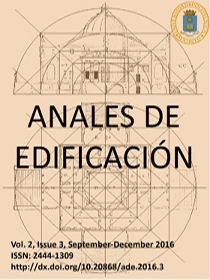Comparación entre redes de fibras sintéticas y redes de fibras de cáñamo para el refuerzo de muros de albañileria = Comparison between synthetic fiber networks and hemp fiber networks for the reinforcement of masonry walls
DOI:
https://doi.org/10.20868/ade.2016.3469Palabras clave:
Fibras naturales, malla FRP, albañilería, técnicas de refuerzo, Natural fibers, FRP mesh, masonry, Reinforcement techniquesResumen
Resumen
La existencia de una gran cantidad de edificios antiguos ha movilizado la investigación para estudiar nuevos sistemas de refuerzo a aquellas construcciones que sean dañadas por decadencia fisiológica o por terremoto. El presente documento demuestra la eficacia de un sistema de refuerzo innovador para los muros de mampostería, constituyentes los elementos estructurales de los edificios históricos. Se hace una comparación entre unas redes bidireccionales de fibras sintéticas tradicionales y las de fibras naturales, ambas pegadas a las dos fachadas del muro con matriz de mortero. El resultado muestra la aplicación de las fibras de cáñamo como refuerzo sísmico y una mayor compatibilidad de estas con el material que caracterizan los edificios antiguos.
Abstract
The existence of a large number of old buildings has mobilized research to study new systems of reinforcement to those buildings that are damaged by physiological decay or earthquake. This document demonstrates the effectiveness of an innovative reinforcement system for masonry walls, which are the structural elements of historic buildings. A comparison is made between bidirectional networks of traditional synthetic fibers and those of natural fibers, both glued to the two facades of the wall with mortar matrix. The result shows the application of hemp fibers as seismic reinforcement and a greater compatibility of these with the material that characterize the old buildings.
Descargas
Referencias
Balsamo A., Iovinella I., Morandini G. (2014). FRG strengthening systems for masonry building, NZSEE Conference.
Calderini C., Cattari S., Lagomarsino S. (2010). The use of the diagonal compression test to identify the shear mechanical parameters of masonry, Construction and building materials – 24, 677-685.https://doi.org/10.1016/j.conbuildmat.2009.11.001
Chiostrini S., Galano L., Vignoli A. (2000). On the the determination of strength of ancient masonry walls. Proceedings of the Research Conference on Earthquake Eng., 2564.
CNR-DT 200/2004, Istruzioni per la Progettazione, l’Esecuzione ed il Controllo di Interventi di Consolidamento Statico mediante l’utilizzo di Compositi Fibrorinforzati. Materiali, strutture di c.a. e di c.a.p., strutture murarie.
Dusi A., Manzoni E. (2011). Seismic retrofit of masonry buildings with polymer grid, NZSEE Conference.
Garofano Angelo (2011). Structural behaviour of masonry walls strengthened with mortar laeyers reinforced with FRP grids. TESIS
Lignola G. P., Prota A., Manfredi G. (2009). Nonlinear analyses of tuff walls strengthened cementitious matrix – grid composites, doi: 10.1061/(ASCE)CC.1943-5614.0000007.
Menna C., Asprone D., Durante M., Zinno A., Balsamo A., Prota A. (2015). Structural behaviour of masonry panels strengthened with an innovative hemp fibre composite grid, Construction and Building Materials – 100, 111-121.https://doi.org/10.1016/j.conbuildmat.2015.09.051
Michele Vinci. (2012). Metodi di calcolo e tecniche di consolidamento per edifici in muratura. Dario Flaccovio Editore.
Parisi F., Iovinella I., Balsamo A., Augenti N., Prota A. (2013). In-plane behaviour of tuff masonry strengthened with inorganic matrix-grid composite, 45, 1657-1666.
Toledo Filho R., Ghavami K., England G. L., Scrinever K. L. (2003). Development of vegetable fibre-mortar composites of improved durability. doi: 10.1016/S0958-9465(02)00018-5.
Descargas
Publicado
Número
Sección
Licencia
1. Los autores conservan los derechos de autor y garantizan a la revista el derecho de una Licencia Creative Commons Atribución - Nocomercial 4.0 Internacional que permite a otros compartir el trabajo con un reconocimiento de la autoría y uso no comercial.
2. Los autores pueden establecer por separado acuerdos adicionales para la distribución no exclusiva de la versión de la obra publicada en la revista (por ejemplo, situarlo en un repositorio institucional o publicarlo en un libro).
Salvo indicación contraria, todos los contenidos de la edición electrónica se distribuyen bajo una licencia de uso y distribución “Creative Commons"












